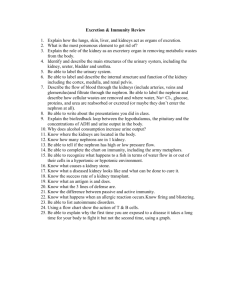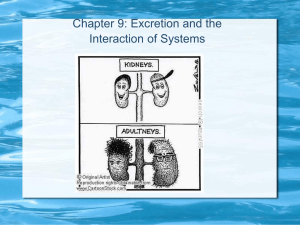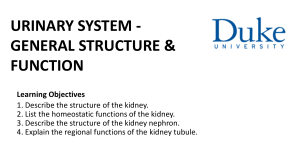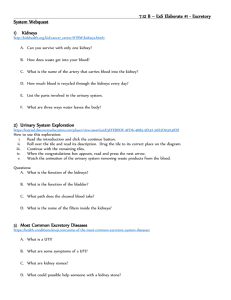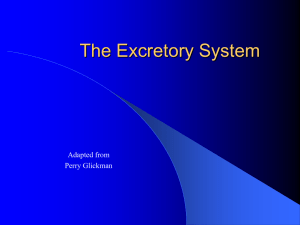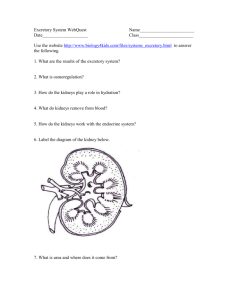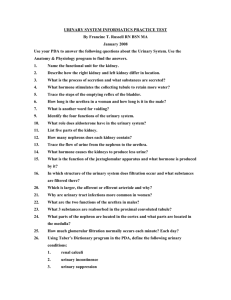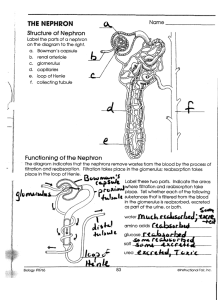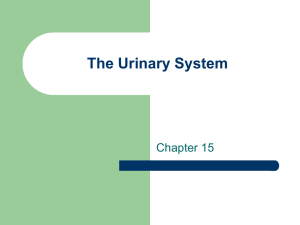Excretory
advertisement
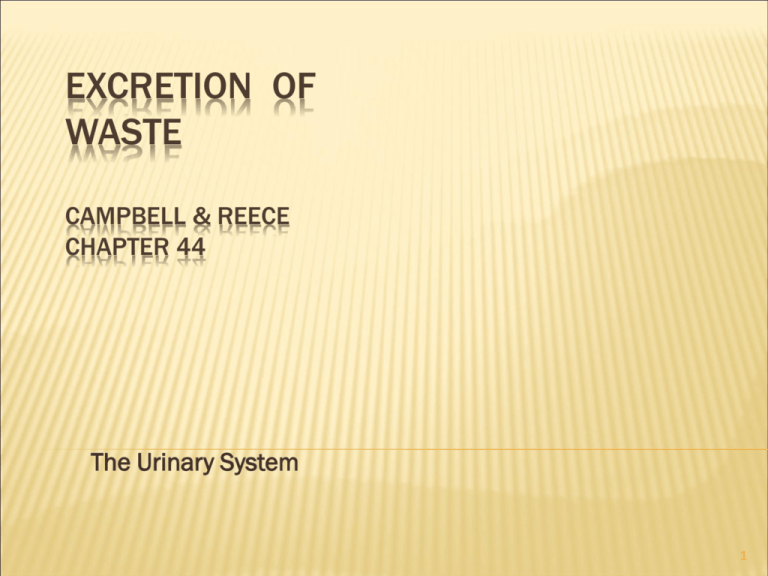
EXCRETION OF WASTE CAMPBELL & REECE CHAPTER 44 The Urinary System 1 HUMAN URINARY TRACT Human urinary tract diagram 2 REGULATION OF THE INTERNAL ENVIRONMENT Regulation of the Chemical Environment Animals = avg. 70% water by weight; 2/3 within cells & 1/3 extracellular fluid (similar to marine environment surrounding earliest cells) Water Compartments Plasma- 7% Interstitial fluid/lymph- 28% Intracellular fluid- 65% Blood Plasma Composition Must be regulated constantly (homeostatic environment); very selective process Monitoring/ analysis/ selection/ rejection Blood Composition is the responsibility of the EXCRETORY organs Nephridia: mollusks, annelids Malpighian tubules: insects Kidneys: vertebrates 3 SUBSTANCES REGULATED BY THE KIDNEYS Regulation needed: Excretion of metabolic wastes Regulation of the concentrations of ions and other chemicals Maintenance of water balance Metabolic Wastes CO2 Nitrogenous compounds: (NH3) ammonia= highly toxic, must convert into nontoxic forms Mammals convert N-wastes to UREA (carried to kidneys to mix with water for excretion) Uric acid salts (crystalline) birds, reptiles, insects waste = whitish paste (dropping) Ion concentrations are regulated: Na+, Cl-, H+, Mg2+, Ca2+, HCO-3 Also excess blood sugar (glucose) Concentrations depend on amount of water in body (hydrated? dehydrated?) 4 WATER BALANCE Some examples of strategies: Freshwater- vs.- saltwater fish Osmosis in /out? Hypertonic / hypotonic environment? "Which must gulp water to maintain itself?" (salt glands for excretion of solutes) Paramecium- contractile vacuoles = "bailing device" Sharks: Isotonicity with surrounding water = (high urea tolerance) Sources of Water Loss and Gain in Terrestrial Animals Gain: drinking, eating water-containing foods, Water also gained as by-product of glucose-oxidation (0.6g water/g glucose), protein oxidation (0.3 g water/g protein), fat oxidation (1.1 g water/g fat) Loss: sweat glands, urine, breathing (water vapor), feces Evolutionary adaptations: kangaroo rat = nocturnal, highly conc. urine, no sweat glands 5 FUNCTION OF THE KIDNEY- FILTRATION, SECRETION, REABSORPTION, EXCRETION The Kidneys (2) = 10 cm long, dark red, bean- shaped kidney animation 6 NEPHRON- THE FUNCTIONAL UNIT OF THE KIDNEY. EACH KIDNEY HAS ABOUT 1.3 MILLION OF THESE LITTLE FILTRATION UNITS! Renal tubule- composed of a MAGNIFIED, THEY LOOK LIKE THIS: proximal (near) and a distal (far) tubule(s), connected by a loop of Henle Nephron ends in Collecting Duct Bowman’s Capsule Glomerulus •Afferent arteriole- leads in to the glomerulus •Efferent arteriole- leads out "Peritubular" capillaries = surround the nephron tubes Venules, Capillaries Loop of Henle Renal pelvis Collecting duct Distal tubule Proximal tubule 7 THE KIDNEY’S JOB: As blood flows though the nephrons, materials are removed from the blood, enter the nephron. Along the way, some materials are re-absorbed back into the bloodstream (osmoregulation and selection happen to maintain blood concentrations) Filtration and removal of metabolic wastes from the blood Urea (nitrogen waste from proteins) Excess Salts Excess Water Excess Glucose (sugar) Excess Minerals (Na+, K+, Ca2+) 8 FORMATION OF URINE: Filtration: materials from the blood are forced out of the glomerulus into the Bowman’s capsule (“filtrate”). Reabsorption: some of the substances that left the blood need to be returned, for homeostasis purposes, and so are selectively diffused or actively transported out of the proximal convoluted tubule back into the capillaries Secretion: final “tweak”. Some more wastes and H+ ions are secreted from the blood into the distal convoluted tubule 9 WHERE IT HAPPENS diagram of the "what" and "where" HERE 10 HUMAN URINARY TRACT Human urinary tract diagram 11 CONTROL OF KIDNEY FUNCTION: THE ROLE OF HORMONES kidney animation Human urinary tract diagram ADH (antidiuretic hormone)- formed by hypothalamus, released by pituitary gland Increase permeability of the Collecting ducts (of the nephrons) to water— more water moves back into blood (decreases water excretion) ADH release is triggered by BP sensors in walls of blood vessels (especially dehydration, hemorrhage…) Alcohol inhibits ADH secretion; symptoms Aldosterone - produced by adrenal cortex; causes reabsorption of NaCl into blood and secretion of K+ into nephron 12
